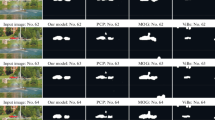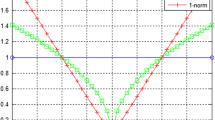Abstract
Low-rank models have been successfully applied to background modeling and achieved promising results on moving object detection. However, the assumption that moving objects are modelled as sparse outliers limits the performance of these models when the sizes of moving objects are relatively large. Meanwhile, inspired by the visual system of human brain which can cognitively perceive the physical size of the object with different sizes of retina imaging, we propose a novel approach, called Collaborative Low-Rank And Sparse Separation (CLASS), for moving object detection. Given the data matrix that accumulates sequential frames from the input video, CLASS detects the moving objects as sparse outliers against the low-rank structure background while pursuing global appearance consistency for both foreground and background. The sparse and the global appearance consistent constraints are complementary but simultaneously competing, and thus CLASS can detect the moving objects with different sizes effectively. The smoothness constraints of object motion are also introduced in CLASS for further improving the robustness to noises. Moreover, we utilize the edge-preserving filtering method to substantially speed up CLASS without much losing its accuracy. The extensive experiments on both public and newly created video sequences suggest that CLASS achieves superior performance and comparable efficiency against other state-of-the-art approaches.








Similar content being viewed by others
Explore related subjects
Discover the latest articles, news and stories from top researchers in related subjects.Notes
Available at: http://chenglongli.cn/people/lcl/journals.html
References
Wen X, Shao L, Xue Y, Fang W. A rapid learning algorithm for vehicle classification. Inf Sci 2015; 295:395–406.
Pan Z, Lei J, Zhang Y, Sun X. Fast motion estimation based on content property for low-complexity h.265/hevc encoder. IEEE Trans Broadcast 2016:1–10.
Pang Y, Cao J, Li X. Learning sampling distributions for efficient object detection. IEEE Transactions on Cybernetics 2016:1–13.
Stauffer C, Grimson WEL. Adaptive background mixture models for real-time tracking. 1999 Proceedings of the IEEE International Conference on Computer Vision. Volume 2; 1999. p. 246–252.
KaewTraKulPong P, Bowden R. An improved adaptive background mixture model for real-time tracking with shadow detection: Springer; 2002, pp. 135–144.
Papazoglou A, Ferrari V. Fast object segmentation in unconstrained video. 2013 Proceedings of the IEEE International Conference on Computer Vision; 2013. p. 1777–1784.
Barnich O, Van Droogenbroeck M. Vibe: A universal background subtraction algorithm for video sequences. IEEE Trans Image Process 2011;20(6):1709–1724.
Van Droogenbroeck M, Paquot O. Background subtraction: experiments and improvements for ViBe. 2012 IEEE Computer Society Conference on Computer Vision and Pattern Recognition Workshops (CVPRW). IEEE; 2012. p. 32–37.
Patel MP, Parmar SK. Moving object detection with moving background using optic flow: IEEE; 2014, pp. 1–6.
Sun D, Roth S, Black MJ. Secrets of optical flow estimation and their principles. 2010 Proceedings of the IEEE Conference on Computer Vision and Pattern Recognition. IEEE; 2010. p. 2432–2439.
Pang Y, Zhu H, Li X, Pan J. Motion blur detection with an indicator function for surveillance machines. IEEE Trans Ind Electron 2016:5592–5601.
Zhou X, Yang C, Yu W. Moving object detection by detecting contiguous outliers in the low-rank representation. IEEE Transactions on Pattern Analysis and Machine Intelligence 2013;35(3):597–610.
Pan J, Li X, Li X, Pang Y. Incrementally detecting moving objects in video with sparsity and connectivity. Cognitive Computation 2015:1–9.
Murray SO, Boyaci H, Kersten D. The representation of perceived angular size in human primary visual cortex. Nat Neurosci 2006;9(3):429–434.
Sperandio I, Chouinard PA, Goodale MA. Retinotopic activity in v1 reflects the perceived and not the retinal size of an afterimage. Nat Neurosci 2012;15(4):540–5422.
Mazumder R, Hastie T, Tibshirani R. Spectral regularization algorithms for learning large incomplete matrices. The Journal of Machine Learning Research 2010;11:2287–2322.
Boykov Y, Veksler O, Zabih R. Fast approximate energy minimization via graph cuts. IEEE Transactions on Pattern Analysis and Machine Intelligence 2001;23(11):1222–1239.
Kolmogorov V, Zabin R. What energy functions can be minimized via graph cuts? IEEE Transactions on Pattern Analysis and Machine Intelligence 2004;26(2):147–159.
Kulchandani JS, Dangarwala KJ. Moving object detection: review of recent research trends. 2015 International Conference on Pervasive Computing (ICPC). IEEE; 2015. p. 1–5.
Wren CR, Azarbayejani A, Darrell T, Pentland AP. Pfinder: Real-time tracking of the human body. IEEE Transactions on Pattern Analysis and Machine Intelligence 1997;19(7):780–785.
Santoyo-Morales JE, Hasimoto-Beltran R. Video background subtraction in complex environments. Journal of Applied Research and Technology 2014;12(3):527–537.
Bouwmans T. Background subtraction for visual surveillance: a fuzzy approach. Handbook on Soft Computing for Video Surveillance 2012:103–134.
Pilet J, Strecha C, Fua P. Making background subtraction robust to sudden illumination changes. European conference on computer vision. Springer; 2008. p. 567–580.
Yubing T, Cheikh FA, Guraya FFE, Konik H, Trémeau A. A spatiotemporal saliency model for video surveillance. Cognitive Computation. 2011;3(1):241–263.
Tu Z, Abel A, Zhang L, Luo B, Hussain A. A new spatio-temporal saliency-based video object segmentation. Cognitive Computation 2016:1–19.
Li C, Cheng H, Hu S, Liu X, Tang J, Lin L. Learning collaborative sparse representation for grayscale-thermal tracking. IEEE Trans Image Process 2016;25(12):5743.
Li C, Lin L, Zuo W, Yan S, Tang J. Sold: sub-optimal low-rank decomposition for efficient video segmentation. Proceedings of the IEEE conference on computer vision and pattern recognition; 2015. p. 5519–5527.
Li C, Lin L, Zuo W, Wang W, Tang J. An approach to streaming video segmentation with sub-optimal low-rank decomposition. IEEE Trans Image Process 2016;25(5):1947–1960.
Torre FDL, Black MJ. A framework for robust subspace learning. Int J Comput Vis 2003;54(1–3):117–142.
Ke Q, Kanade T. Robust l1 norm factorization in the presence of outliers and missing data by alternative convex programming. 2005 Proceedings of the IEEE Conference on Computer Vision and Pattern Recognition. Volume 1. IEEE; 2005. p. 739–746.
Jiang B, Ding C, Tang J. Graph-laplacian pca: Closed-form solution and robustness. Proceedings of the IEEE Conference on Computer Vision and Pattern Recognition; 2013. p. 3492–3498.
Candès EJ, Li X, Ma Y, Wright J. Robust principal component analysis? Journal of the ACM (JACM) 2011;58(3):1–36.
Zhou Z, Li X, Wright J, Candes E, Ma Y. Stable principal component pursuit. 2010 IEEE International Symposium on Information Theory. IEEE; 2010. p. 1518–1522.
Dou J, Li J, Qin Q, Tu Z. Moving object detection based on incremental learning low rank representation and spatial constraint. Neurocomputing 2015;168(C):382–400.
Xin B, Tian Y, Wang Y, Gao W. Background subtraction via generalized fused lasso foreground modeling. 2015 Proceedings of the IEEE Conference on Computer Vision and Pattern Recognition; 2015. p. 4676–4684.
Li C, Wang X, Zhang L, Tang J, Wu H, Lin L. Weld: Weighted low-rank decomposition for robust grayscale-thermal foreground detection. IEEE Transactions on Circuits and Systems for Video Techniques 2016;1(1):1–14.
Recht B, Fazel M, Parrilo PA. Guaranteed minimum-rank solutions of linear matrix equations via nuclear norm minimization. SIAM Rev 2010;52(3):471–501.
Cai JF, Candès EJ, Shen Z. A singular value thresholding algorithm for matrix completion. SIAM J Optim 2010;20(4):1956–1982.
Li SZ. Markov Random field modeling in image analysis. Springer. 2009.
Lu J, Shi K, Min D, Lin L, Do MN. Cross-based local mul ipoint filtering. 2012 Proceedings of the IEEE Conference on Computer Vision and Pattern Recognition. IEEE; 2012. p. 430–437.
Kopf J, Cohen MF, Lischinski D, Uyttendaele M. Joint bilateral upsampling. ACM Trans Graph (TOG). 2007;26(3):1–5.
Goyette N, Jodoin PM, Porikli F, Konrad J, Ishwar P. Changedetection. net: A new change detection benchmark dataset. 2012 IEEE Computer Society Conference on Computer Vision and Pattern Recognition Workshops (CVPRW). IEEE; 2012. p. 1-8.
Toyama K, Krumm J, Brumitt B, Meyers B. Wallflower: Principles and practice of background maintenance. The Proceedings of the Seventh IEEE International Conference on Computer Vision, 1999. Volume 1. IEEE; 1999. p. 255–261.
Davis J, Goadrich M. The relationship between precision-recall and ROC curves. International Conference on Machine Learning; 2006. p. 233–240.
Fu Z, Sun X, Liu Q, Zhou L, Shu J. Achieving efficient cloud search services: multi-keyword ranked search over encrypted cloud data supporting parallel computing. IEICE Trans Commun. 2015;98(1):190–200.
Fu Z, Sun X, Ji S, Xie G. Towards efficient content-aware search over encrypted outsourced data in cloud. IEEE INFOCOM 2016-The 35th Annual IEEE International Conference on Computer Communications. IEEE; 2016. p. 1–9.
Author information
Authors and Affiliations
Corresponding author
Ethics declarations
Funding
This study was funded by the National Nature Science Foundation of China (61502006), the Natural Science Foundation of Anhui Province (1508085QF127), and the Natural Science Foundation of Anhui Higher Education Institutions of China (KJ2014A015, KJ2015A110, KJ2016A114 and KJ2015ZD44).
Informed Consent
Informed consent was obtained from all individual participants included in the study.
Conflict of interests
The authors declare that they have no conflict of interest.
Additional information
Ethical Approval
All procedures performed in studies involving human participants were in accordance with the ethical standards of the institutional and/or national research committee and with the 1964 Helsinki declaration and its later amendments or comparable ethical standards.
Rights and permissions
About this article
Cite this article
Zheng, A., Xu, M., Luo, B. et al. CLASS: Collaborative Low-Rank and Sparse Separation for Moving Object Detection. Cogn Comput 9, 180–193 (2017). https://doi.org/10.1007/s12559-017-9449-5
Received:
Accepted:
Published:
Issue Date:
DOI: https://doi.org/10.1007/s12559-017-9449-5




